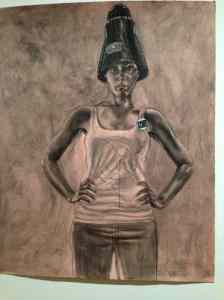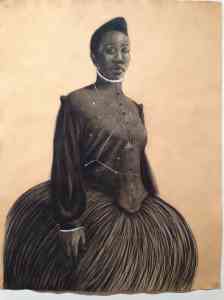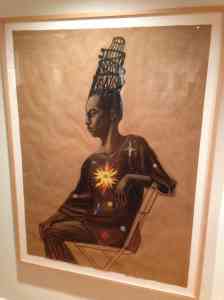
History repeats – a 1765 silk Robe d’anglaise with Agatha Ruiz de la Prada’s 2009 ribbon-and-wire runway creation
Within FIT’s upstairs gallery, you’ll receive a master class (from the masters) on how to take something old, inject it with an inspired twist, and create Vogue-ready looks ready for the modern world in FIT’s show RetroSpective, running through November 16.
FIT curator Jennifer Farley did an outstanding job of selecting iconic looks associated with well-dressed woman from previous centuries and pulling interpretation after interpretation on that theme from FIT’s collection. Historical references, empire waists, hoop skirts, and leg-o-mutton sleeves all get the old/new side-by-side treatment in the galleries.

History reinterpreted –elevated sandal created by David Evins for Elizabeth Taylor in her 1961 epic, Cleopatra
How did forward-looking designers mine ancient cultures, textures, and materials and make them look current? Look no further than the Grecian evocation of Madame Grés, sandals designed by David Evins for Liz’s 1961 Cleopatra look, Valerie Porr’s 1960s take on Guinevere, and Versace gone baroque. Click on the links to see the pieces on the show’s website.
Was there ever a time that rhinestone buckles weren’t applied to dainty evening shoes? Apparently not in the last several centuries, since examples from the 1740s are displayed alongside Peter Yapp 1910 satin pumps, 1959 Julianelli suede pumps, and 1995 red-velvet Manolos.
In the section on bustles, you’ll see beautiful 1870s creations alongside bustle-inspired works by Schiaparelli (1939), Herrera (1988), and Anna Sui (1999). But across the aisle in the section on hoop skirts, you expect to see 1860s dresses next to more modern works by Hishinuma (1996), Rochas (2004), and Thom Browne (2013). But who could expect to see hoops from the Fifties – Hoop-la (1956), which kept your bouffant skirt fluffed out, and the amazing Belle O’ the Ball collapsible skirt hoop (in its original box!), which allowed every girl-on-the-go to sleep easier knowing that her bouffant could be perfectly pouffed wherever she travelled.
If you love fashion, get to this show and enjoy additional meditation on the decades of transformations associated with the New Look, corsets, platform pumps, playsuits, paper dresses, clogs, grunge, and graffiti. If you can’t get to the show, take some time to look through the show’s website to see about a third of what’s there and to read more about each concept and creation. FIT did a beautiful job on it.
And maybe someone from FIT can explain how Norell made such a perfectly pleated 1965 flapper dress for Lauren Bacall out of wool crepe?
























